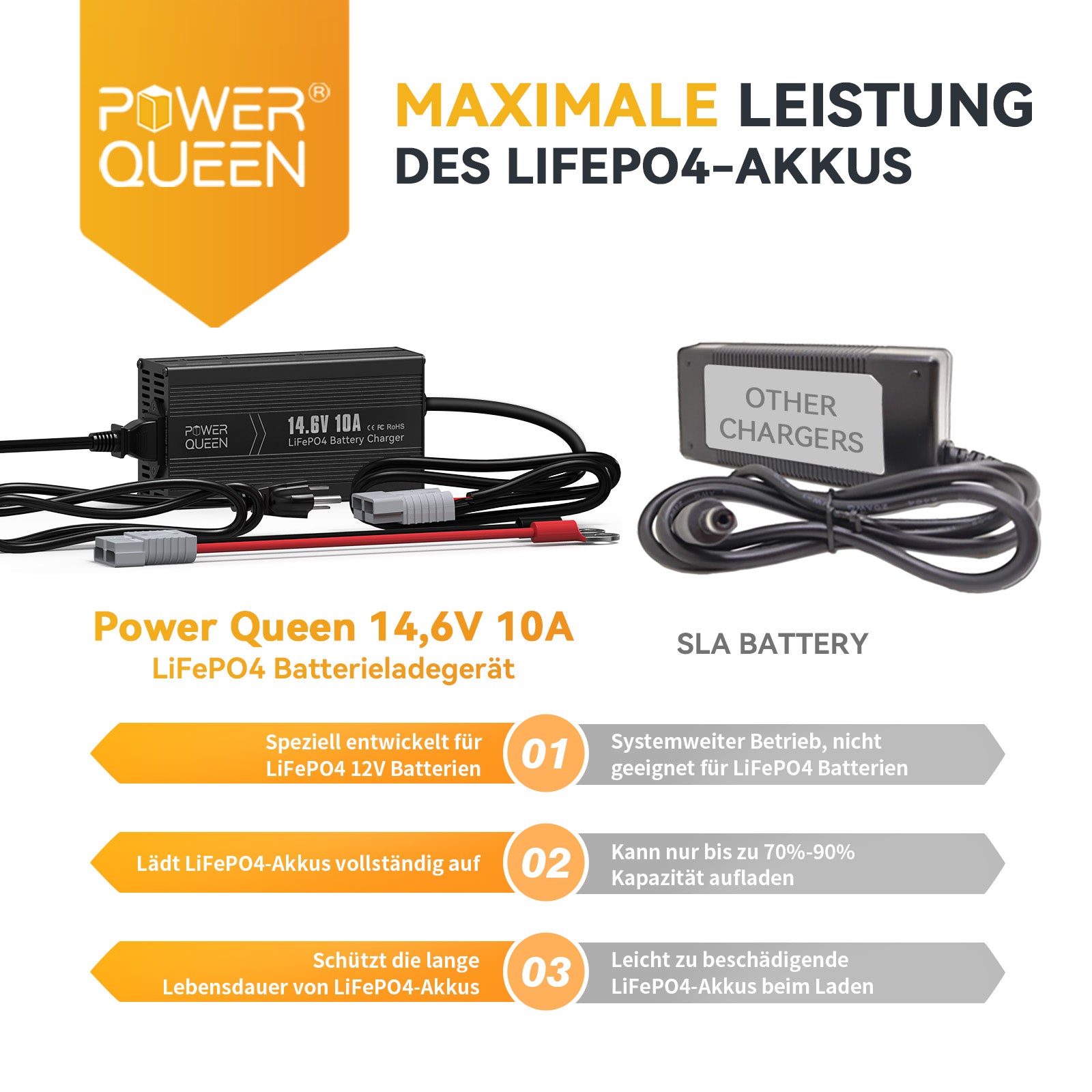
7 errors that you should avoid when charging LIFEPO4 batteries
, From Sally Zhuang, 6 min reading time
Power Queen Energy for every generation - with sustainable and clean energy solutions create a better future for all families. Whether you supply your grandparents 'slow electric car, your parents' fishing boat, your motorhome or your children's electric scooters - we take care of the energy needs of each family member.
Show more >Contact us – your satisfaction is our motivation! Our dedicated team is happy to answer any questions, provide product information, or provide technical support and looks forward to hearing from you. Customer Service: service.de@ipowerqueen.com
Show more >Power Queen not only offers high-quality lithium batteries, but also a living community. Do not miss any news, special offers and tips for using our products. Become part of the Power Queen family and benefit from inspiring content and direct interaction with our team.
Show more >The stories of our customers have helped Power Queen to grow enormous growth and strength. We work with various customers to bring sustainable energy to every house and to master the challenges of energy supply in difficult environments. Their stories started when they met Power Queen ...
Show more >On this page you will find valuable insights from other users who help you make the right decision. We hope that you will take part in the evaluation and help us to improve our commitment to excellence with your feedback!
Show more >In our battery science area, we offer you exciting insights and well-founded information about lithium batteries. Learn more about innovative applications and tips for the optimal use of your batteries. Our goal is to convey the necessary knowledge to you so that you can fully exploit the advantages of our products.
Show more >Users report on their experiences and test results from practice and give them an insight into the performance and reliability of our lithium batteries. Find out how our batteries are used in everyday life and convince yourself of your quality and efficiency.
Show more >In our shopping guide, we help you to understand the differences between our different battery models and make the best choice for your needs. You are well informed with our detailed comparisons and expert recommendations.
Show more >In this area we present exciting feedback and experiences of users who have used our lithium batteries for their DIY electricity projects. Find out how customers implemented your individual projects after the purchase and what advantages you have gained through the use of our batteries.
Show more >A life full of energy: influencers report! Find out how these creative influencers use our lithium batteries to support their adventures, be it when traveling, camping or creative projects. Let yourself be infected by your innovative ideas and passion for sustainable energy.
Show more >
, From Sally Zhuang, 6 min reading time
Charging a LiFePO4 battery, also known as a lithium iron phosphate battery, requires careful attention to ensure its longevity and optimal performance. Errors during the charging process can lead to shortened battery life, reduced capacity, or even safety risks.
In this blog, we discuss some common mistakes you should avoid when charging LiFePO4 batteries so you can maximize their efficiency and lifespan.
One of the biggest mistakes to avoid is overcharging your LiFePO4 battery. Exceeding the recommended battery voltage can cause damage to the internal chemical structure, resulting in reduced capacity and potentially even a shortened battery life.
Although lithium-ion batteries (LiFePo4 batteries) usually have built-in safety mechanisms (BMS) to prevent overcharging, it is important to follow the manufacturer's guidelines for proper use and to minimize potential hazards.

Symptoms of an overcharged battery may include swelling, leakage, increased temperature, smoking, and decreased performance.
On the other hand, undercharging a LiFePO4 battery can also have harmful effects. Insufficient charging can lead to reduced energy capacity, limiting the battery's ability to effectively power your devices. Avoid over-discharging the battery before charging and strive to maintain a proper charging cycle to ensure optimal performance.
Another mistake you should avoid is the use of chargersthat are not specifically designed for LiFePO4 batteries. Different batteries have different charging requirements and therefore require special chargers. Using incompatible chargers not only reduces charging efficiency but also poses a safety risk.

While it's true that there's a wealth of information available online, it's important to exercise caution and avoid misleading information when it comes to chargers. Just because someone may have had success with an incompatible charger in the past doesn't guarantee the same result for your battery. If you have any doubts or concerns about the charging process, please contact the manufacturer directly. They can provide accurate information and, if necessary, assist you in finding and purchasing a suitable charger. Attempting to DIY the battery yourself could jeopardize its lifespan and pose safety risks, so it's always better to rely on the manufacturer's expertise.
Below you will find the charging voltage references for LiFePO4 batteries.

Some chargers have built-in safety features designed to protect both the battery and the user. These features may include overcharge protection, short-circuit protection, and temperature controls.
Ignoring these safety features and using a charger that does not have these safety features can put both you and your device at risk.Overcharging a battery can cause it to overheat and potentially catch fire, while short circuits can damage the battery or pose a safety hazard. Temperature controls prevent overheating and further protect your battery.
When purchasing a charger, be sure to check for these safety features. While they cost a bit more, they provide crucial protection and peace of mind.
Extreme temperatures, both high and low, can negatively impact the performance and lifespan of LiFePO4 solar batteries, although they are generally less temperature-sensitive than lead-acid batteries. Charging LiFePO4 batteries at high temperatures can trigger a thermal runaway reaction, in which the LiFePO4 battery generates more heat than it can dissipate. This can lead to dangerous situations such as fires or explosions. Therefore, it is important to charge these batteries in a suitable environment to ensure safety and avoid potential hazards.
Likewise, exposing LiFePO4 batteries to extremely low temperatures can have negative effects. Cold temperatures can slow the chemical reactions within the battery, resulting in reduced efficiency and slower charging rates. In severe cases, sub-freezing temperatures can even cause irreversible damage to the battery structure.
To avoid these problems, it is essential to adhere to the temperature range specified by the manufacturer for charging LiFePO4 batteries. This range is typically between 0°C and 45°C (32°F and 113°F). Charging batteries outside this range may result in reduced performance and possibly a shorter lifespan. If you live in areas with long winters, batteries with Low temperature protection crucial for you. Check out the Power Queen 12V 100Ah Smart LiFePO4 batteries If the temperature is below 0 °C (32 °F), the BMS interrupts the charging process.
To maximize the lifespan and performance of LiFePO4 batteries, it is important to properly charge them before storeThis includes storage in a cool, dry environment, away from direct sunlight and extreme temperatures. It is recommended to keep LiFePO4 batteries at a partial charge, typically between 30% and 50%, to prevent self-discharge during storage.
Before connecting a stored LiFePO4 battery to a charger, it is important to thoroughly inspect it for any physical damage or signs of swelling. If any problems are detected, do not continue charging the battery, as this may pose a safety risk. In such cases, it is advisable to contact the battery manufacturer or seek the assistance of a professional for safe handling and guidance.
This is suitable for the battery system, in which batteries are connected in series or parallelWhen charging LiFePO4 batteries, it is important to avoid rapid charging without proper cell balancing. LiFePO4 batteries consist of multiple cells connected in series and parallel to achieve the desired voltage and capacity. During the charging process, each cell can reach its full capacity at different times, leading to voltage imbalances.If these imbalances are not corrected, some cells may be overcharged while others are undercharged, which can lead to reduced battery performance and possible damage.
To prevent cell voltage imbalances, it is essential to use a charger that supports cell balancing or an external cell balancer. Cell balancing ensures that all cells reach their full capacity simultaneously, improving overall battery performance and extending its lifespan. By using a charger with built-in balancing capabilities or connecting an external balancing device, users can effectively manage and maintain equal cell voltages during charging.
In summary, it's important to be careful and well-informed when choosing a charger for your batteries. Avoid blindly following the success claims of others with incompatible chargers and instead rely on accurate information from the battery manufacturer. Take your time to research and invest in a charger that meets your battery's voltage and current requirements, and always prioritize safety features and quality. This way, you can ensure optimal performance, longevity, and safety for both your battery and your device.
Free shipping within the EU🚛 (except islands)
Reply within 24 hours🤝
5-year warranty👑
Free shipping within the EU🚛 (except islands)
Reply within 24 hours🤝
5-year warranty👑


